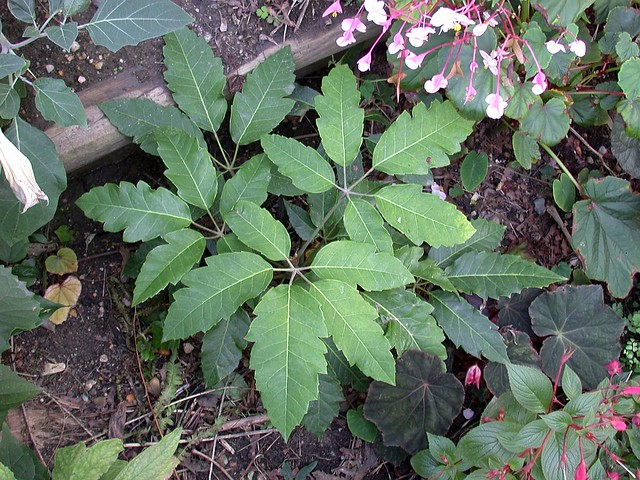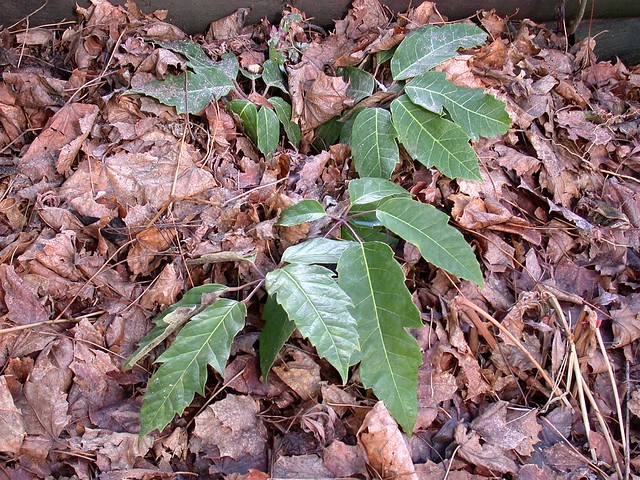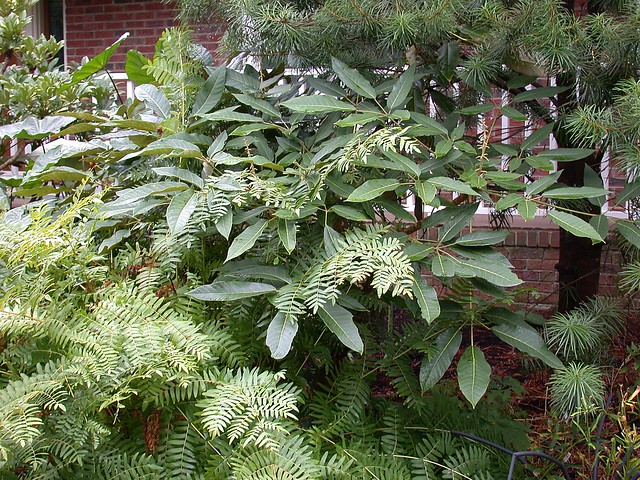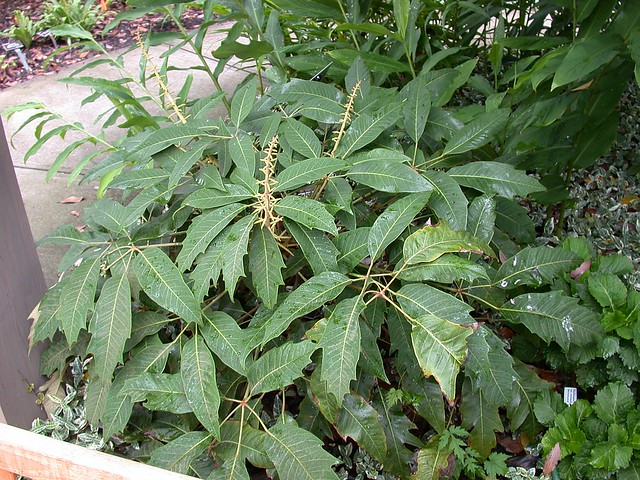
Schefflera delavayi, October 2014
I wrote about Schefflera delavayi, one of the hardiest species of this primarily tropical and subtropical genus of the family Araliaceae, a year ago. For more information about this species and its background, please see my earlier article: Schefflera delavayi. (Interestingly, that article is now one of the top search results for this species name on Google.)

Schefflera delavayi, December 2013
I picked up my plant during a very enjoyable visit to Raleigh, North Carolina last summer for one of Plant Delights Nursery's open houses. The PDN catalog describes this species as hardy from zone "7b to 9b, at least", so this is definitely experimental in my zone 7a/b climate. Spring planting is usually preferable for marginally hardy plants, to allow them to get themselves established before winter. Because I got it in the ground so late in the growing season (August), I did protect the plant for the winter, first with a heavy mulch of autumn leaves, and then for a few days during our coldest weather in early January with an overturned plastic pot. I left it uncovered the rest of the winter and it came through with minimal damage.

Schefflera delavayi, winter protection (early January 2014, at 5 degrees F)
Of course by "minimal damage" I mean it still had some green leaves left on it! A few leaves died and there was some (slight) evidence of cold damage but most of the damage was probably mechanical, from the overturned pot and from freezing rain and snow cover later in the winter. I was a bit nervous about its survival at first because it was very late to break dormancy, but finally began to put out new growth in early May. My plant gets direct sun for several hours in the morning, and bright shade for the rest of the day. When I planted it in my heavy clay-based soil, I gave it my standard amendment and fertilization of leaf compost mixed with green sand, bone meal, and dried blood. It has otherwise not received any fertilization, and the only care I gave it this year was occasional watering during our dry spells, and cutting back some faster-growing plants that threatened to shade it out.

Schefflera delavayi, new spring growth, May 2014
This species seems to have some variation in the degree of leaflet serration, with some in photos I've seen on the web having such deeply lobed leaflets that it's hard to believe this is all the same species. I'm not sure if this is due to variation in age, represents different collections of the species, or if some of these plants are just plain misidentified. The seedlings from which I selected my own plant showed a range of leaflet serration, and this may be a juvenile characteristic that is lost with age; the mature plant at PDN has leaflets with nearly entire (undivided) edges.

Schefflera delavayi, Plant Delights Nursery/Juniper Level Botanical Garden (August 2014)

Schefflera delavayi, JC Raulston Arboretum (August 2014)
Schefflera delavayi seems to do quite well in the Pacific Northwest but Tony Avent warned me that this species is slow-growing in our east coast climate. My own plant is still quite small, and while it didn't gain much stature this year it looks healthy and I'm pleased with its survival and growth. Maybe next year it will start to emerge above the other plants! There are several other supposedly hardy species of this genus now in cultivation, with S. taiwaniana being especially attractive. I may try this species eventually, although Tony warned me that he has tried it in Raleigh and found it wasn't sufficiently heat tolerant.

Yours is a particularly nice specimen and I'm glad it's doing do well for you. I was out at Cistus in early August and among the various S. delavayi seedlings Sean had found a most wonderful one with deeply serrated leaves. Even he was excited about it. The differences among S. taiwaniana are almost as pronounced.
ReplyDeleteAt a talk last night, the guys from Dancing Oaks showed a more mature S. delavayi that had deeply serrate leaves. So I still don't know if it's genetic, or cultural, or what. BTW the more I look at my own plant, the more I'm wondering about the matte appearance, especially when the foliage was so glossy last year! I definitely prefer the glossy look.
DeleteGlad to see that it has sailed through fine for you, albeit with some protection. Now that it has been planted for quite some time potentially it can do a big growth spurt next year.
ReplyDeleteI just hope it "sails" through another winter and would love to see it attain some height next year! I'm still debating whether to protect it. I guess I'll just wait and see what the forecast says. At least my protection method is quick and easy!
Delete